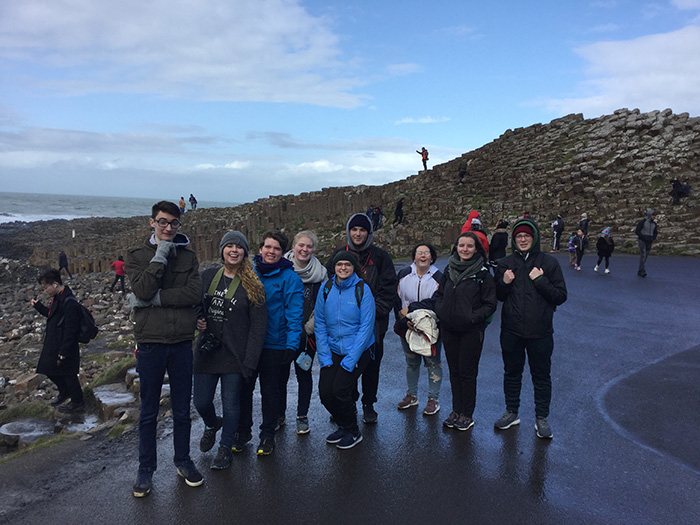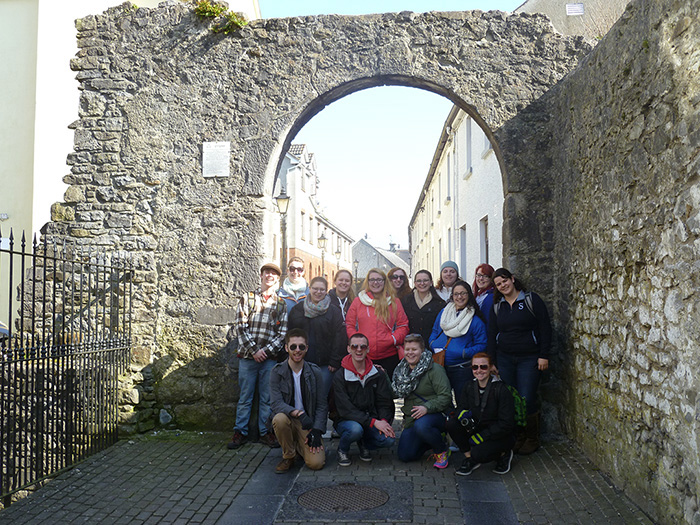Ireland Travel Course
Explore the rich history and culture of Ireland. The course will acquaint students with Ireland’s history, culture, and society by visiting historical sites, museums, vibrant cities, and the Irish countryside.
 Spring 2019
Spring 2019
(Plan to return in 2024)
Dr. Anthony Daly
$2,100
Course Description
Prior to and after the trip, students will have weekly meetings with Professor Anthony Daly, the faculty leader of the trip, to discuss issues relating to Irish history, culture and society. Students will be required to finish assigned readings and submit assignments.
During the trip, Professor Daly and other guides will give on-site talks and tours, and students will be required to keep a journal. After the trip, students will complete a final project based on their knowledge of, and experience in, Ireland.
Students will be evaluated on the following: attendance at class meetings, participation in discussions, written tests, in-class presentations, written assignments on course readings, a final reflective project on the knowledge and experience gained in the course, and behavior on the travel portion of the course.
Learning / Course Objectives
- Students will be able to identify connections between Irish history and contemporary Ireland.
- Students will be able to compare and contrast the depictions of Irish society in fiction and non-fiction works with their experiences in Ireland.
- Students will be able to explain points of similarity and difference in their experiences in Northern Ireland (UK), the Republic of Ireland, and the United States.
- Students will be able to situate the value of their travel within their larger college experience.
DESTINATION INTRODUCTION
 Dublin
Dublin
Dublin, the capital of the Republic of Ireland, is drenched in history and culture. Wonderfully walkable, the city offers visitors famous sights such as Trinity College, Dublin Castle, and of course the Georgian architecture of the eighteenth century. Side by side with these landmarks are the green parks, bustling streets, and hip neighborhoods of modern Dublin, one of Europe’s most vibrant capitals. This is a city made famous by writers and poets such as James Joyce, Jonathan Swift, and W.B. Yeats, but we will also experience the history of Dublin, with visits to Kilmainham Jail, which held so many Irish patriots in past centuries, the National Museum, and the Book of Kells, a an illustrated manuscript from over a thousand years ago.
One of the highlights of our time in Dublin will be a day trip into the Wicklow Mountains
National Park to experience the splendor of Glendalough. The name means “Valley of
the Two Lakes” in the Irish language, and it is one of the most inspiring spots in
Ireland, with the remains of a monastery, founded in the sixth century, set in great
natural
beauty.
Belfast
Belfast is a wonderful city with stunning buildings from the nineteenth century and streets that date back to the 1600s. We will see reminders of the conflicts from past years, but also the transformation of a newly confident city and its friendly people. With Belfast as a base, we will also explore the beauty of county Antrim, highlighted by the Giant’s Causeway, recognized by the United Nations as a World Heritage Site. This natural marvel of 55 million year-old hexagonal columns is situated on the rugged and scenic Irish coast, where green fields meet the sea.
 Kilkenny
Kilkenny
We will take the train through the countryside to Kilkenny. If Belfast is Victorian and Dublin is Georgian, Kilkenny takes us back further; the Medieval Mile stretches from Kilkenny Castle to St. Canice’s Cathedral. Walk a little more and find winding alleys, a striking abbey, and a round tower that you can climb for a view of the city and beyond. Kilkenny has played a prominent role in Ireland’s bloody history, especially in the seventeenth century, but today the town’s history is matched with a busy contemporary life in shops, music, sports, and restaurants.
TRIP PARTICULARS (subject to change)
Cost: $2, 300 per person
All inclusive features include:
- Flights to and from Ireland and bus/train fares during the trip
- Accommodations (triple or quadruple shared rooms in hotels or hostels with shared bathrooms)
- Breakfast and dinner on most days
- Admission to these attractions: Book of Kells at Trinity College, Giant’s Causeway, Kilkenny Castle, St. Canice’s Cathedral, Kilmainham Jail
Three upper-level credits for MCLA students
Contact Information
Anthony Daly
History and Political Science
(413) 662-5478
Anthony.Dale@mcla.edu
Professor Daly teaches a variety of courses in world and European history, including Irish and British history. He has travelled to Ireland more than a dozen times.
